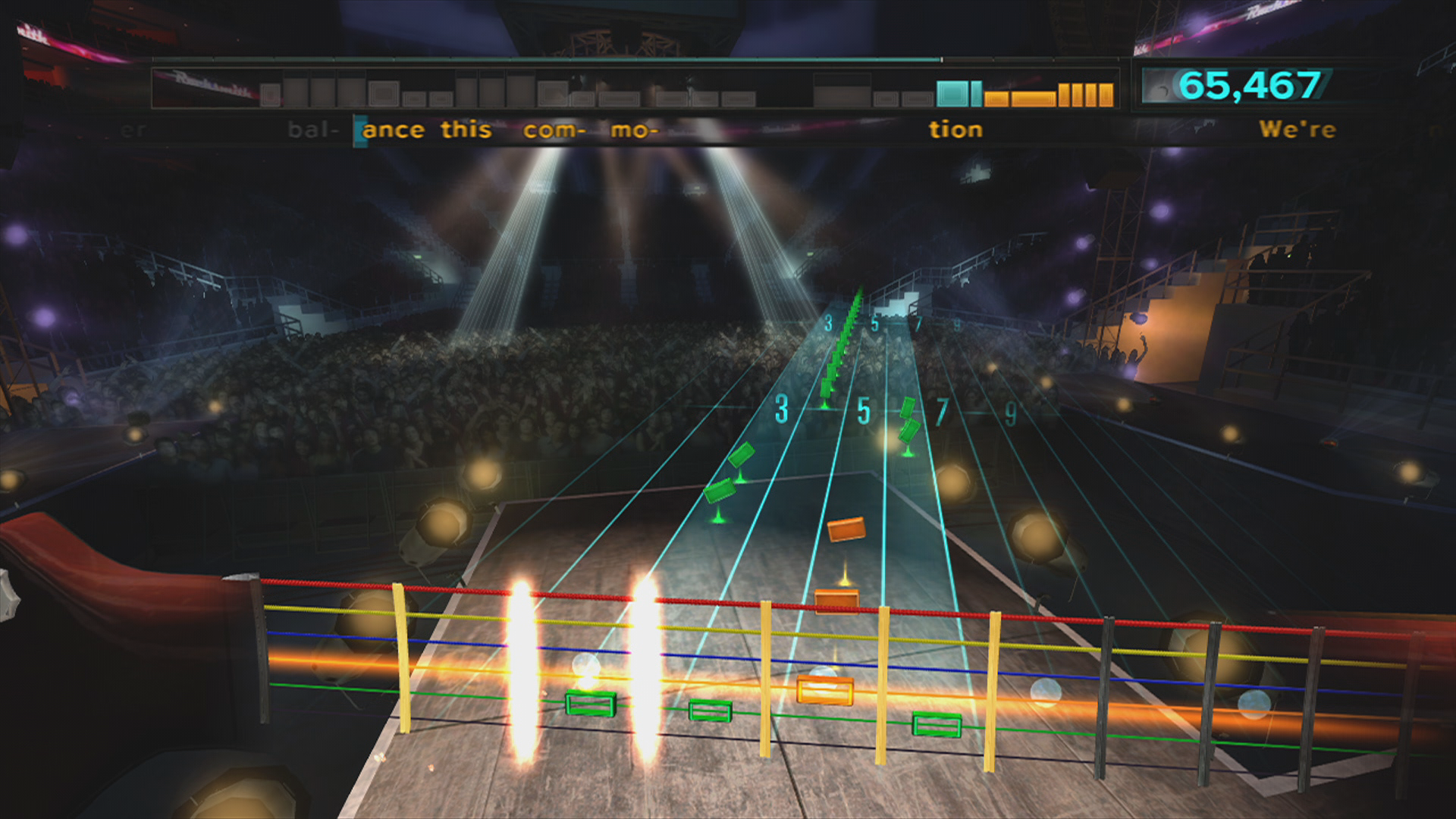Rocksmith Review
If you are fond of the concept of educational music games like Rocksmith, it means that we have something in common. Personally, I feel the desire and ambition to learn to play the guitar well. However, as soon as it comes into my hands, I simply don’t know what to do with it and where to start. Nevertheless, I still believe that with a certain amount of perseverance, it is possible to take my skills to a completely new level.
Regardless of whether you have experience with a real instrument or not, and without assigning the game the role of a genre savior, Rocksmith still needs to answer one fundamental question: will it truly teach you how to play the guitar, or will you just be able to complete the game while holding this musical instrument?
The answer to this question is very important, but you will not be able to get it right away. Despite the fact that we have something quite impressive in terms of technology, the game does not spoil us with plug-and-play devices. Firstly, you must strictly follow the instructions to avoid using HDMI for video and audio. Secondly, you need to invest a considerable amount of money in a good audio system for your home theater and buy a whole bunch of special cables (which are as rare in stores these days as video cassettes or “Mayak” tape recorders). And of course, don’t forget about two other important purchases: the electric guitar itself (if you don’t have one yet) and a copy of the game.
Before you successfully play the first note, you will also need to spend a certain amount of time debugging the software that processes audio and visual signals, depending on the model of your TV. Step by step, you will be able to eliminate lag to a certain level, when everything will start working more or less stably, and the touch of the first string will no longer sound from the speakers like some incomprehensible farting noise.

After the game is finally properly set up, it immediately immerses you in the world of the career mode. In this mode, you constantly practice playing simple melodies at first, and then more complex songs. All of this takes place on a stage in front of a crowd of wildly cheering fans. The game interface is both understandable and intimidating at the same time. You see a guitar neck with strings in front of you, and various icons “run” onto it. There are different symbols that indicate whether you should fret the string, leave it open, or even do a portamento (slide along the neck). You are also reminded on which frets all these techniques should be performed.
At first, it seems that watching all your hits on the right strings at the right time will be a very exciting activity. But soon enough, the highly advertised system of increasing difficulty based on your progress starts to become tiresome: in the career mode, every successful move you make is immediately taken into account by the game’s artificial intelligence, and the difficulty increases gradually but constantly. Therefore, you can either unknowingly soar to the heights of musical fame or fall from there in an instant by making a mistake.
Despite the fact that increasing difficulty forces us to learn new techniques and improve our skills, it has very little direct educational effect. Perhaps this aspect of the game would have looked better if it had been presented in a separate section that could be revisited every time you felt that you had achieved perfection in a certain technique. It could have been something like a bonus chapter at the end of your “journey” through the game, which could demonstrate to you that mastery truly comes with time. Instead, it looks as if Rocksmith is ashamed of the fact that its educational function is being noticed more than its entertainment value. And in order to redeem its perceived guilt, it tries its best to resemble Guitar Hero, where entertainment takes the main role.
It should also be noted that the career mode has a rather complex interface, which the player has to constantly figure out instead of moving on to perform the next composition while their fingers still remember the correct positions for recently learned techniques. This interface consists of an unclear clutter of horizontally and vertically dropping submenus with consistently slow display speed. For example, I have been playing Rocksmith for over three weeks, but the menu-building system still occasionally puts me in a state of indescribable anger.

Hidden deep within the depths of this clumsy interface, there is an option in the game that allows you to set the difficulty range, specifying the lower and upper limits of your abilities. However, to find where it is located, you will have to make a thorough effort. Additionally, among the settings, you will find a way to change one of the most annoying default options in Rocksmith. The game is initially set up to show you the fretboard of your guitar in a mirrored reflection, with the string order from top to bottom. I believe that regardless of a person’s level of professionalism, this way of displaying the fretboard is simply terrible, so it needs to be changed as a top priority.
A spoonful of honey in a barrel of tar is the option to work with individual songs. Here, you can play your favorite compositions at a comfortable pace, honing your skills on specific transitions, riffs, and chords. The game gradually guides you through the challenging parts of each song. The tempo of these exercises is specifically designed to promote your personal progress. I would advise you not to rush to move on to a new track as quickly as possible to satisfy your curiosity, but instead spend a long time on one song, perfecting its performance. This way, you will achieve the best educational effect. In other words, you will actually be learning to play the guitar, rather than just playing a computer game.
In this mode, you will eventually master every difficult part of a song and feel extremely proud of it. Your face will light up with a genuine smile of joy when all the pieces come together to form a complete song. And if you consider the moderate tempo of execution, you will realize that without even noticing it, you have already learned to play “Are You Gonna Go My Way” by Lenny Kravitz. This once again demonstrates the lack of thoughtfulness in the career mode of the game, where you also make progress, but at the cost of such effort and nerves that sometimes you resemble a driven horse rather than a guitarist enjoying their playing.
Unlike the selection of songs to perform, which, although presented in different genres, mostly belong to the good old rock, the collection of mini-games is truly diverse. In a game where you have to shoot ducks, you have to quickly move your fingers along the entire length of the fretboard, pressing the necessary strings to kill the duck: a very logical way to teach someone to place their left hand fingers correctly. The game “Baseball” requires more subtle skills: in it, you have to play arpeggios to hit the ball thrown by the pitcher. Additionally, with the help of your guitar, you can kill zombies, play Tetris, and more: all of this is done to turn you into a confident musician, if not a virtuoso.

No matter how anyone feels about Rocksmith, it cannot be denied that this game is addictive. Over the past few weeks, I have completely lost my peace: despite the fact that it often frustrated me, I still wanted to come back to it every time to learn another new passage. Playing Rocksmith, I have spent more time with a guitar in my hands than in the last twenty years (and my left hand fingers haven’t seen calluses in a long time either). And my efforts have not been in vain: now I can easily play “Are You Gonna Go My Way”!
When I connect my guitar directly to the amplifier again, the game filters that beautifully cleaned up the sounds of my playing disappear, and I hear again how my clumsy fingers slide on the fretboard, accompanied by a characteristic squeak from the speakers. And then comes the realization: yes, unfortunately, I definitely didn’t become Lenny Kravitz. However, it is also true to say that I have made significant progress. And if that was the main goal of the game, then it was definitely achieved.
But still, how do I correctly answer the question I formulated at the beginning of the review: does Rocksmith teach us to play the guitar, or does it teach us how to play the game with a guitar in hand? The answer, as always, lies somewhere in the middle. On one hand, it will definitely give you a sense of satisfaction with your own results in communicating with the instrument. On the other hand, you will simply enjoy the fact that you are holding a real guitar in your hands and progressing further in the colorful journey displayed on the TV screen (despite the occasional frustration from the disproportionate increase in difficulty). Perhaps the less you treat Rocksmith as a game, the more enjoyment you will be able to get from it.
Share
Discuss
More Reviews





